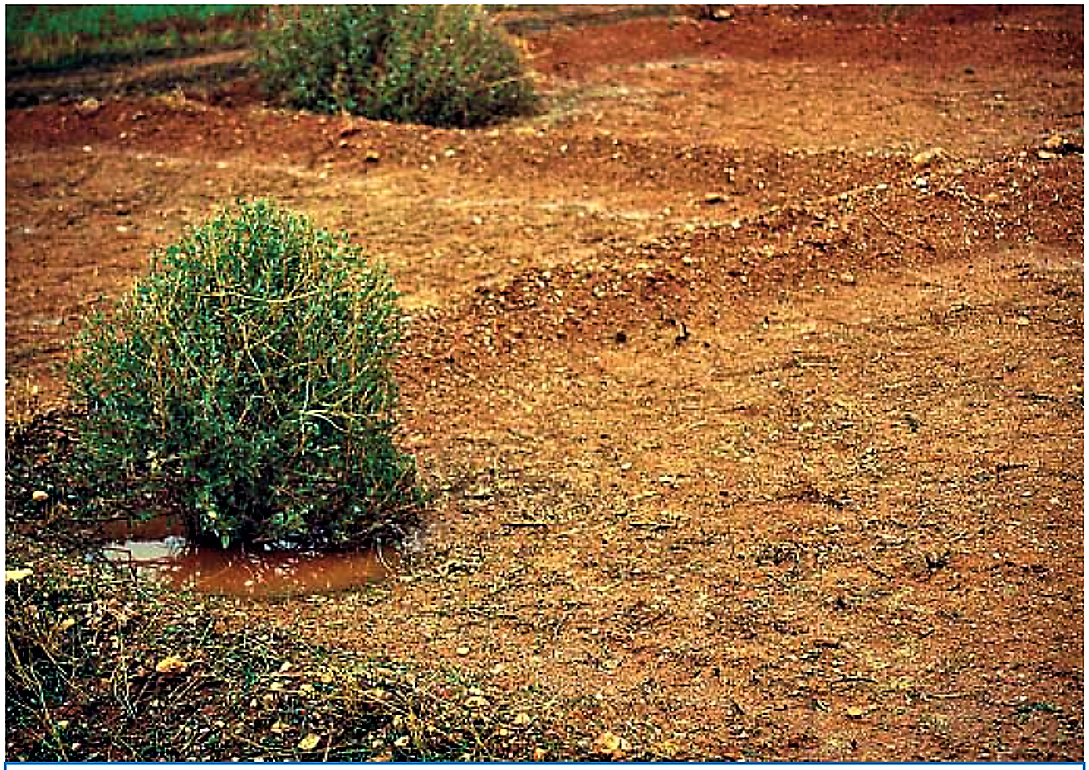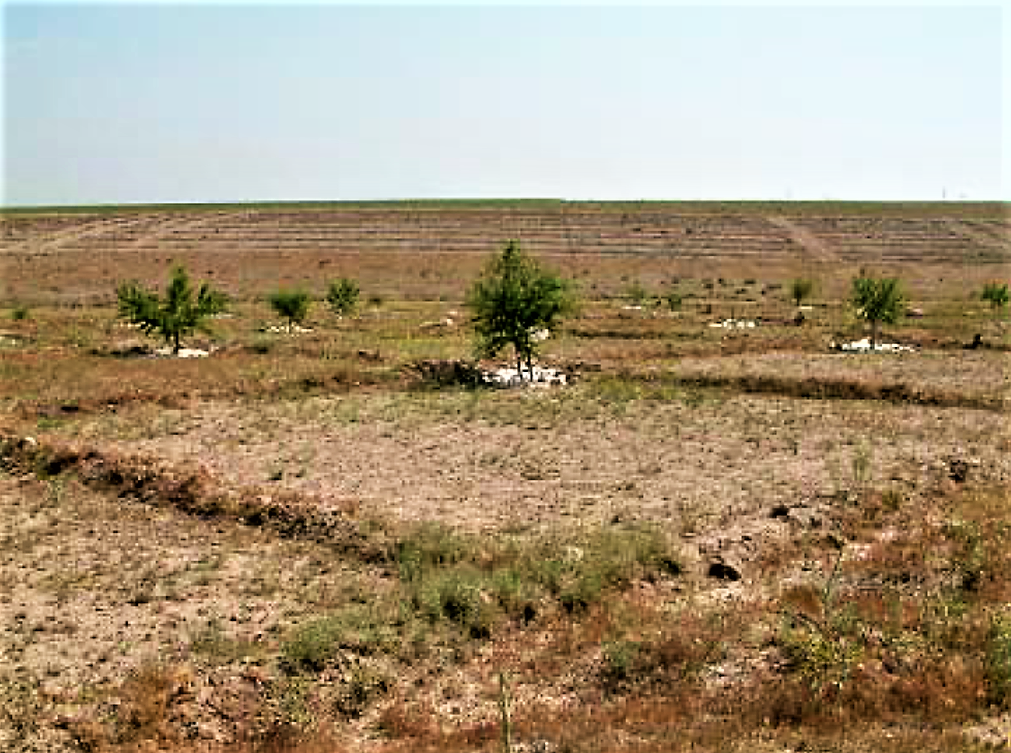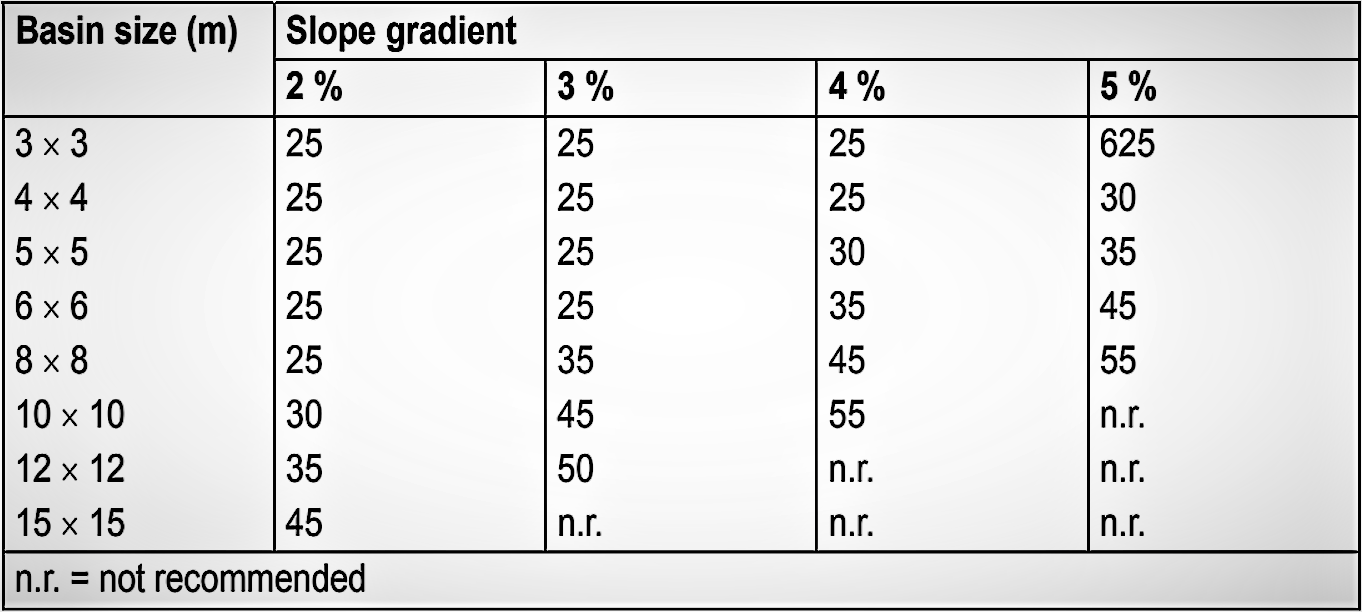Micro basins are a common technique used in agriculture to collect surface run-off, increase water infiltration and prevent soil erosion. Their principle is comparably simple: small pools are surrounded by stone walls and/or soil ridges on all sides to collect the rainwater and surface run-off. This allows storing rainwater and using it for small-scale tree and bush planting, enabling increased growth of plants if there is a moisture deficit. The basins may vary strongly in size (ranging between 10 and 100 m2) depending on the planted crop. Sometimes, basins are also constructed directly around the plant. The main restriction for implementing micro basins is the depth of the soil, which should be at least 1.5 metres.
| Entradas | Salidas |
|---|---|
Freshwater, Food Products |
Micro basins are used in order to store precipitation water by collecting surface run-off: low soil ridges – optionally supported with stone walls - are constructed in an enclosed shape to form a basin, which helps to prevent the water to further run off. The collected rainwater is then used for direct irrigation or infiltration into the soil to enhance soil moisture and recharge groundwater (see also optimisation of water use in agriculture, conservation of soil moisture, surface and surbsurface groundwater recharge).
To use the water most effectively, pits are dug within the basin, storing more collected water and protecting it from evaporation (ADB 2008). As rainwater accumulates in these lower parts of the micro basins, crops or trees are best directly planted in the pits (MALESU 2007).

Micro basins show a similar design to semi-circular bunds, except that they are entirely surrounded by ridges. The benefit of this design using closed micro basins is higher water storage efficiency. On the other hand, as a disadvantage, excess water cannot run off and surface run-off has to be stronger to enter the pits.
Micro basins are just one type of micro-catchment. For other micro-catchment techniques, see also bunds, field trenches and planting pits.
Different design types are possible, including half-moon, v-shaped, diamond-shaped, trapezoidal, as well as contour bund basins. Micro basins are mostly used for small-scale tree and bush planting in areas with moisture deficit (ANSCHUETZ et al. 2003). Each basin consists of a catchment area and an infiltration pit, which serves as the cultivated area. The field can be additionally protected from excess water runoff with the construction of a cut-off drain or a retention ditch (IRHA 2011).

V-shaped micro basins are also called “negarims”. They are particularly common for fruit tree production in Israel and in several districts of Kenya (MALESU 2007).
The height of the ridges relies strongly on the slope and the size of the catchment. Calculations may be done according to the following table:

The size of a micro basin is usually between 10 to 100 m2, even though larger dimensions are possible, especially if more than one tree is planted in a catchment or if they are applied on flat ground.
Constructing micro basins does not need special material apart from a shovel and a tube-level or some other instrument for finding the contour line. Otherwise, the implementation of micro basins is a comparably cheap measure.
Adapted from ANSCHUETZ et al. (2003)

The construction of micro basins cannot be mechanised and is done by hand following six steps:
- Detecting and marking the contour line (d), for example by using a tube level.
- The diagonal of the micro-basin is measured and marked along the contour line ((a) and (b)). Further points are detected along the contour line, using the same distance.
- Point (c) is found by using two strings with the same length fixed at point (a) and (b). A mark is made where the two strings meet.
- The following lines of micro basins are found one by one using the same procedure.
- The infiltration pits are then marked and dug out in each micro basin.
- The basins need to be cleared of all vegetation. Then, the bunds are constructed: first, they are to be constructed to half their final height. For firmness, this first layer is compacted. In a second step, more material is added to reach the wanted height. Finally, the bunds are again compacted and evened out.

Damage to the basins needs to be repaired immediately. If there is unexpectedly high rainfall, the danger for breaking embankments rises (MALESU 2007). Also, the micro basins have to be cleaned from unwanted vegetation. However. grass growing on the bunds of the basins can protect the walls from erosion.
| Working principle | Soil ridges (optionally supported with stones) are constructed on all sides to create a small basin to prevent water to run off. Pits are dug in the lower parts of the basin, where crops and trees are planted to store the water and enhance soil moisture. Optionally, the stored water may also be used for irrigation. |
| Capacity/adequacy | Easy to construct and simple design. |
| Performance | High for soil with low moisture and enough depth (min. 1.5 m). |
| Costs | Low. |
| Self-help compatibility | High. |
| O&M | On-going repair of the bunds is necessary. |
| Reliability | Embankments may break, especially if there is high rainfall. |
| Main strength | Easy to apply. |
| Main weakness | Frequent repair required; Only for small scale. |
Micro basins are very easy to construct. They are best used for small-scale tree planting in areas with low soil moisture (ANSCHUETZ et al. 2003). The main limitation for micro basins is the depth of the soil, which should be at least 1.5 m, because plants such as trees are placed in pits within the basin. Even deeper soil (of about 2 m) is preferred. If the soil is not deep enough, planted trees may not be able to cultivate enough roots.
Rainwater Cisterns. Traditional Technologies for Dry Areas
Rainwater cisterns are indigenous underground water storage structures, widely used in the Matrouh area in north-western Egypt, in steppe areas in Syria and Jordan, and elsewhere. Little information is available on the design, construction and operation of traditional cisterns. Most available publications on water cisterns deal with rooftop water harvesting, using pre-fabricated materials. These cisterns are of very limited capacity (a few cubic meters) and are more expensive than underground cisterns. Most publications on rainwater harvesting are written for water professionals and researchers, not for local users and development practitioners. This publication responds to the needs expressed by water users, and especially ICARDA’s research and development partners. It will also be useful to policy makers responsible for water development in dry areas.
ALI, A., OWEIS, T., SALKINI, A.B. and EL-NAGGAR, S. (2009): Rainwater Cisterns. Traditional Technologies for Dry Areas. Aleppo: International Center for Agricultural Research in the Dry Areas (ICARDA) URL [Visita: 13.03.2019] PDFWater Harvesting and Soil Moisture Retention
The water harvesting techniques described in this booklet are particularly useful in arid and semi-arid areas, but the techniques described for soil moisture conservation are also of use in sub-humid regions.
ANSCHUETZ, J. KOME, A. NEDERLOF, M. NEEF, R. de VEN, T. van de (2003): Water Harvesting and Soil Moisture Retention. Wageningen: Agromisa Foundation URL [Visita: 06.08.2012] PDFNegarim Micro-Catchments
Green Water Management Handbook. Rainwater Harvesting for Agricultural Production and Ecological Sustainability
This handbook highlights the principles and technologies that can be used to harness the huge untapped potential of rainwater. Instead of a stereotyped view focusing only on rivers and groundwater, the book directs readers in recognising rain as the ultimate source of water for food production and other uses in rural economies across Africa.
MALESU, M.M. ; ODUOR, A.R. ; ODHIAMBO, O.J. (2007): Green Water Management Handbook. Rainwater Harvesting for Agricultural Production and Ecological Sustainability. Nairobi: The World Agroforestry Centre URL [Visita: 13.03.2019] PDFLand Husbandry – Components and Strategy. 70 FAO Soil Bulletin
Response of Almond Trees to Micro Catchments Water Harvesting (MCWH) Methods in the Northwest of Iran
Rainwater Harvesting Handbook. Assessment of Best Practices and Experience in Water Harvesting
The main objective of this handbook on rainwater harvesting is to provide the African Development Bank with an effective reference tool for including various rain water harvesting approaches and techniques in the programming and design of projects.
ADB (2008): Rainwater Harvesting Handbook. Assessment of Best Practices and Experience in Water Harvesting. Tunis-Belvedere, Tunisia: African Development Bank (ADB) URL [Visita: 04.10.2013] PDFRainwater Harvesting Technologies for Small Scale Rainfed Agriculture in Arid and Semi-arid Areas
This paper is a review of simple water harvesting techniques, which have been tested and found useful in arid and semi-arid regions, and which might be suitable for use in other areas. The paper also tries to show some successful cases of application of water harvesting techniques in African countries, which have increased the overall productivity of smallholder farms and hence improved farmers’ livelihood.
IBRAIMO, N. MUNGUAMBE, P. (2007): Rainwater Harvesting Technologies for Small Scale Rainfed Agriculture in Arid and Semi-arid Areas. Maputo: University Eduardo Mondlane URL [Visita: 13.03.2019] PDFWater Harvesting
Water harvesting has been practiced successfully for millennia in parts of the world – and some recent interventions have also had significant local impact. Yet water harvesting’s potential remains largely unknown, unacknowledged and unappreciated. These guidelines cover a wide span of technologies from large-scale floodwater spreading to practices that collect and store water from household compounds.
MEKDASCHI STUDER, R. LINIGER, H. (2013): Water Harvesting. Guidelines to Good Practice. Bern/Amsterdam/Wageningen/Rome: Centre for Development and Environment (CDE), Rainwater Harvesting Implementation Network (RAIN), MetaMeta, The International Fund for Agricultural Development (IFAD) URL [Visita: 12.03.2019] PDFImproving Crop Production through Rainwater Harvesting. Moroto District Case Study (Uganda)
This study presents water harvesting in rain-fed agriculture and identifies key management challenges in present set of field experiences on the technique options for increased water productivity in small holder farming in drought-prone areas of the Moroto district in Uganda. Water harvesting techniques that conserve both soil and water were encouraged, such as: Tie-ridging, Negarims, Planting pits.
ANNENA, J. (2008): Improving Crop Production through Rainwater Harvesting. Moroto District Case Study (Uganda). Florence: University of Florence PDFWorld Agroforestry
This webpage offers an overview on micro basins for fruit tree production. Other rainwater harvesting techniques are described.

